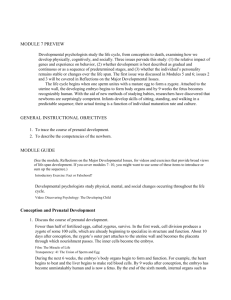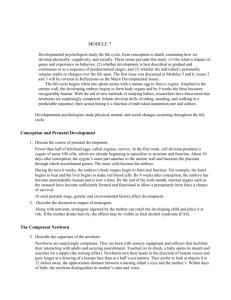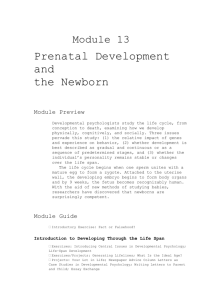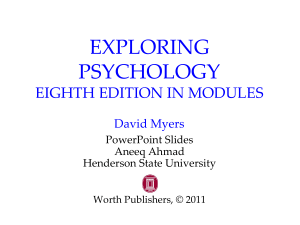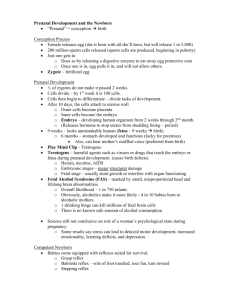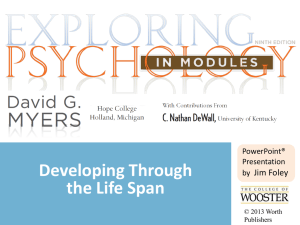Prenatal Development and the Newborn
advertisement
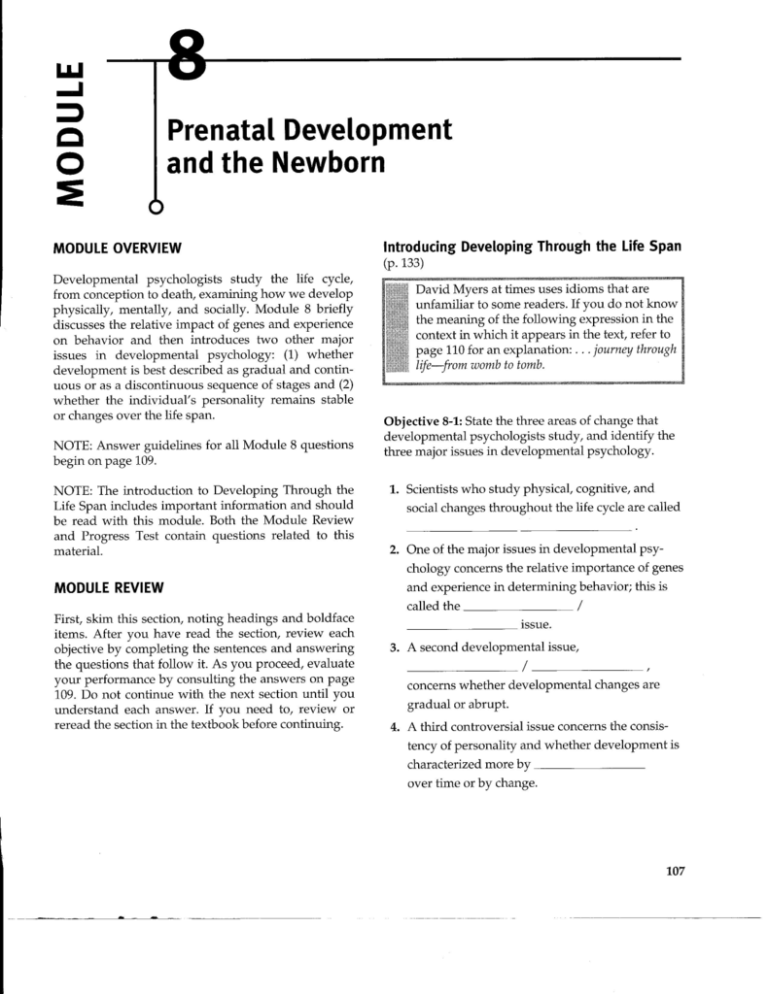
LI.I ....I :::l C o :e Prenatal Development and the Newborn MODULE OVERVIEW Introducing Developing Through the life Span (p.133) Developmental psychologists study the life cycle, from conception to death, examining how we develop physically, mentally, and socially. Module 8 briefly discusses the relative impact of genes and experience on behavior and then introduces two other major issues in developmental psychology: (1) whether development is best described as gradual and continuous or as a discontinuous sequence of stages and (2) whether the individual's personality remains stable or changes over the life span. NOTE: Answer guidelines for all Module 8 questions begin on page 109. NOTE: The introduction to Developing Through the Life Span includes important information and should be read with this module. Both the Module Review and Progress Test contain questions related to this material. MODULE REVIEW First, skim this section, noting headings and boldface items. After you have read the section, review each objective by completing the sentences and answering the questions that follow it. As you proceed, evaluate your performance by consulting the answers on page 109. Do not continue with the next section until you understand each answer. If you need to, review or reread the section in the textbook before continuing. David Myers at times uses idioms that are unfamiliar to some readers. If you do not know the meaning of the following expression in the context in which it appears in the text, refer to page 110for an explanation: ... journey through life-from womb to tomb. Objective 8-1: State the three areas of change that developmental psychologists study, and identify the three major issues in developmental psychology. 1. Scientists who study physical, cognitive, and social changes throughout the life cycle are called 2. One of the major issues in developmental psychology concerns the relative importance of genes and experience in determining behavior; this is called the ________ / issue. 3. A second developmental issue, ------~/------concerns whether developmental changes are gradual or abrupt. 4. A third controversial issue concerns the consistency of personality and whether development is characterized more by _ over time or by change. 107 I 108 Module 8 Prenatal Development and the Newborn Conception (pp.134-135) The Competent Newborn (pp.136-138) Objective 8-2:Describe the union of sperm and egg at conception. Objective 8-4: Describe some abilities of the newborn, and explain how researchers use habituation to assess infant sensory and cognitive abilities. 1. Conception begins when a woman's 1, When an infant's cheek is touched, it will vigor- releases a mature 2. The few from the man that reach the egg release digestive ~ ously search for a nipple, a response known as the _ 2. American psychologist _ that eat away the egg's protective covering. As believed that the newborn experiences a "bloom- soon as one sperm penetrates the egg, the egg's ing, buzzing confusion." This belief is ________ (correct/incorrect). surface all other sperm. 3. The egg and sperm become one. fuse and Give some evidence supporting the claim that a newborn's sensory equipment is biologically prewired to facilitate social responsiveness. Prenatal Development (pp.135-136) Objective 8-3:Define zygote, embryo, and fetus, and explain how teratogens can affect development. 1. Fertilized human eggs are called ________ . During the first week, the cells in this cluster begin to specialize in structure and function, that is, they begin to ________ . The outer part of the fertilized egg attaches to the forming the wall, 3, (Close-Up) To study infants' thinking, develop- _ 2. From about 2 until 8 weeks of age the developing human, formed from the inner cells of the fertilized egg, is called a(n) _ During the final stage of prenatal development, the developing human is called a(n) 3. Along with nutrients, a range of harmful substances known as through the placenta. can pass 4, Moderate consumption of alcohol during preg- nancy (usually does not affect/ can affect) the fetal brain. If a mother drinks heavily, her baby is at risk for the birth defects and mental retardation that accompany _ mental researchers have focused on a simple form of learning called _ which involves a in respond- ing with repeated stimulation. Using this procedure, researchers have found that infants can discriminate _ ________ ,and _ they also understand some basic concepts of ________ and _ Answers 109 PROGRESS TEST KEY TERMS Circle your answers to the following questions and check them with the answers on page 110. If your answer is incorrect, read the explanation for why it is incorrect and then consult the appropriate pages of the text. Using your own words, on a piece of paper write a brief definition or explanation of each of the following terms. 1, developmental psychology 2. zygote Multiple-Choice Questions L Dr. Joan Goodman is studying how memory changes as people get older. She is most likely a(n) psychologist. a. social c. developmental b. cognitive d, experimental 2. The rooting reflex occurs when a: a. newborn's foot is tickled. b. newborn's cheek is touched. c. newborn hears a loud noise. d, newborn makes eye contact with his or her caregiver. 3. A child can be born a drug addict because: a, drugs used by the mother will pass into the child's bloodstream. b, addiction is an inherited personality trait. c. drugs used by the mother create genetic defects in her chromosomes. d. the fetus' blood has not yet developed a resistance to drugs. 4. A child whose mother drank heavily when she was pregnant is at heightened risk of: a. being emotionally excitable during childhood. b. becoming insecurely attached. c. being born with the physical and cognitive abnormalities of fetal alcohol syndrome. d. addiction to a range of drugs throughout life. 5. Which is the correct order of stages of prenatal development? a. zygote, fetus, embryo b. zygote, embryo, fetus c. embryo, zygote, fetus d, embryo, fetus, zygote 6. (Close-Up) Habituation, the simple form of learnng used by researchers to demonstrate the capabilities of the newborn, demonstrates the extent of infant: a, hearing. b. motor development. Co rooting reflex. d, cognition. 3. embryo 4. fetus 5. teratogens 6. fetal alcohol syndrome (FAS) 7. rooting reflex 8. habituation ANSWERS Module Review Introducing Developing Through the Life Span L developmental psychologists 2, nature/nurture 3. continuity/stages 4. stability Conception 1. ovary; egg 2. sperm; enzymes; blocks 3. nuclei Prenatal Development L zygotes; differentiate; uterine; placenta 2. embryo; fetus 3. teratogens 4. can affect;fetal alcohol syndrome The Competent Newborn 1. rooting reflex 2. William James; incorrect Newborns reflexively turn their heads in the direction of human voices. They gaze longer at a drawing of a human face than at a bull's-eye pattern. They focus best on objects about 8 to 12 inches away, which is about the distance between a nursing infant's eyes and the mother's. Within days, they recognize their mother's smell and voice. 3. habituation; decrease; colors, shapes, sounds; numbers; physics 110 Module 8 Prenatal Development and the Newborn Progress Test Multiple-Choice Questions 1. c. is the answer. Developmental psychologists study physical, cognitive (memory, in this example), and social change throughout the life span. a. Social psychologists study how people influence and are influenced by others. b. Cognitive psychologists do study memory; because Dr. Goodman is interested in life-span changes in memory, she is more likely a developmental psychologist. d. Experimental psychologists study physiology, sensation, perception, learning, and other aspects of behavior. Only developmental psychologists focus on developmental changes in behavior and mental processes. 2. b. is the answer. The infant turns its head and begins sucking when its cheek is stroked. a., c., & d. These stimuli produce other reflexes in the newborn. 3. a. is the answer. Any drug taken by the mother passes through the placenta and enters the child's bloodstream. b. Addiction cannot be inherited; it requires exposure to an addictive drug. c. Drugs may disrupt the mechanisms of heredity, but there is no evidence that such changes promote addiction. d. This answer is incorrect because at no age does the blood "resist" drugs. 4. c. is the answer. a., b., & d. A child's emotional temperament, attachment, and addiction have not been linked to the mother's drinking while pregnant. S. b. is the answer. FOCUS ON VOCABULARY AND LANGUAGE Page 139: As we journey through life-from womb to tomb-when, how, and why do we develop? In the process of becoming who we are, and as we travel (journey) through life, from conception to death 6. d. is the answer. a. & c. Hearing ability and the rooting reflex are not demonstrated in these experiments. b. Although motor development is noted, showing this is not a goal of habituation experiments. Key Terms L Developmental psychology is the branch of psychology concerned with physical, cognitive, and social change throughout the life span. 2. The zygote (a term derived from the Greek word for "joint") is the fertilized egg, that is, the cluster of cells formed during conception by the union of sperm and egg. 3. The embryo is the developing prenatal organism from about 2 weeks through 2 months after conception. 4. The fetus is the developing prenatal human from 9 weeks after conception to birth. S. Teratogens (literally, poisons) are any drugs, viruses, or other substances that cross the mother's placenta and can harm the developing embryo or fetus. 6. Fetal alcohol syndrome (FAS) refers to the physical and cognitive abnormalities that heavy drinking by a pregnant woman may cause in the developing child. 7. The rooting reflex is the newborn's tendency, when his or her cheek is stroked, to orient toward the touch, open the mouth, and search for the nipple. 8. A simple form of learning used to study infant cognition, habituation is decreasing responsiveness to a stimulus that is repeatedly presented. (womb to tomb) we change and mature physically, psychologically, and socially. (Another humorous expression describing the life span or life cycle is from "sperm to worm.")
